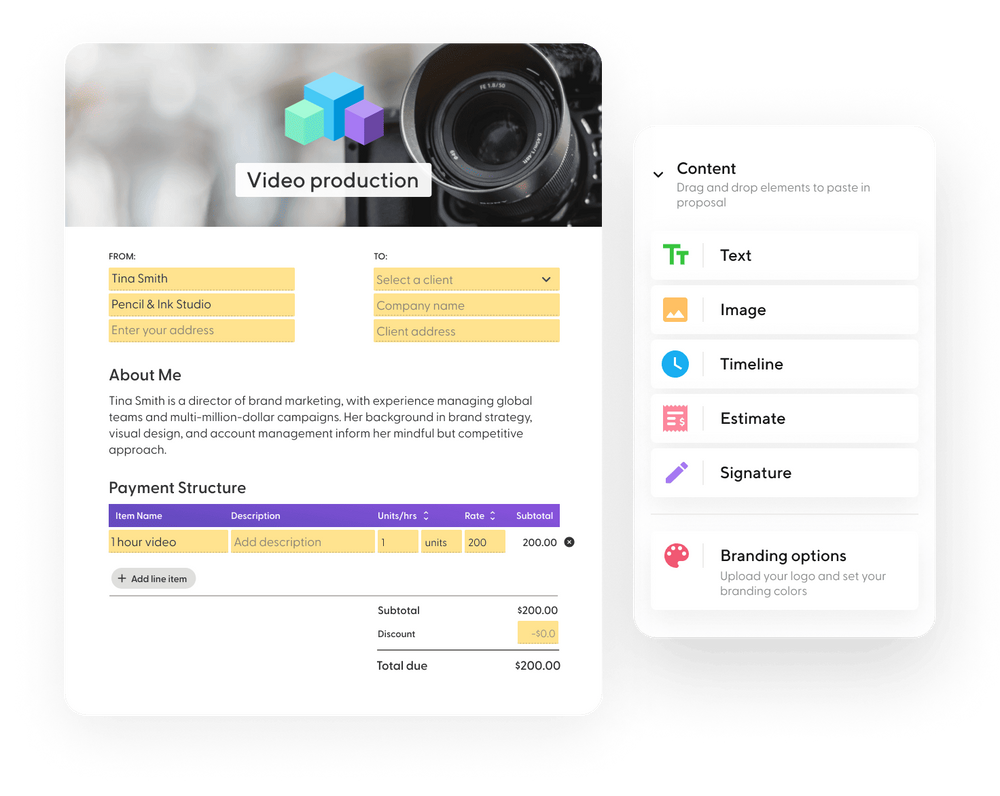You’ve found a lead, congrats! The next step is putting together a proposal for your work. People send many different types of proposals, with several different types of formats, but generally, the type of information that needs to be included stays the same.
For a content creation or content marketing proposal, there are several key things to consider.
Before You Put Together Your Content Marketing Proposal
Before sitting down to write your proposal, talk with your potential customer to understand what their needs are. Sometimes clients have an understanding of what they’re looking for, but other times, they need more direction. For a content marketing proposal, clients are coming to your agency with the knowledge that they want to create new content.
Do They Have a Content Marketing Strategy?
Find out if they know what type of content they’re looking for - blogs, resources, support articles, etc. In some cases, within your content marketing scope, you may need to include an additional budget for strategy, audience research, and/or competitive analyses to help determine what types of content should be created.
They Have a Strategy and Need Competent Content Marketers
In other cases, the proposal is much more specific. They have the strategy and want you to execute the work. Either way, knowing where the client is at will make it much easier to have a specific proposal that’s more likely to close. Position your marketing agency as the solution they need for their content marketing strategy.
What To Include in Your Content Marketing Proposal
While your proposal itself will depend on the client’s specific needs, there are certain elements every marketing proposal should include.
Overview and Goals
The first thing to include in your content marketing proposal is an overview of your services and the goals you're working towards. For content marketing, your relevant goals could include:
- Increase traffic by X amount
- Create X new pieces of content
- Determine what types of content to create and make a plan of execution
The goals are everything you’re working towards that you’ll go into more details following the proposal.
Scope of Work
The scope of work includes the full and specific details of everything that you’re proposing. This includes any strategy work, execution, planning, and everything else that is relevant. No one wants to work for free, so avoid scope creep by paying attention to this section.
Content Strategy
Content strategy is often part of content marketing proposals and scopes. This is the foundational work to help determine the customer's content marketing needs. From target audience personas to competitive analyses, there are several considerations to think about when creating a content marketing plan for your potential customer.
Types of Content
Some of the most prominent types of content in the freelancing world are articles, blogs, and landing pages. However, there are several types of content that should be outlined.
Consider what types of content you are going to either create or strategize. For example, these could include:
- Social media posts
- Website pages
- Ad copy
- Blog posts and articles
- Resources and guides
- Videos
- Case Study Writing
If you are putting together a proposal for content execution, outline how many of each type of content they will be receiving within the scope.
Frequency of Program Work
Inside of the scope of work for a content marketing proposal, it may be relevant to include how often you will be delivering the pieces of content. This may be on a daily, weekly, biweekly, or monthly basis, but regardless, it helps your potential client understand all the value they’ll be receiving and how often.
Site Analytics Data Gathering
Earlier in the proposal, you should have outlined what the goals and objectives of the engagement were. The analytics section outlines how you are going to measure the goals. If the goal is simply the amount of content produced, it may be simple to show these metrics.
However, it’s rare that your client will only care about what is produced, not how well it’s doing. Helping them understand how often you will be reporting toward the goals shows them that you are actively engaged in making sure the goals are met.
Example Scope of Work for Content Marketing Proposal
Your specific SOW will depend on the type of work the client wants. However, these are some examples that could be part of your proposal.
Competitor Analysis
- What are competitors doing in this space that is making them successful or unsuccessful? Remember, competitors aren't just direct competitors that have similar products but are those that are also ranking in the SERPs (Search Engine Results Pages). Understanding both SERP competitors and direct competitors allows us to identify where we can create competitive content.
- What types of content are ranking well in the SERPs?
Keyword Research & Keyword Matrix (SEO Research) for Keyword Targeting
- Identify keywords and topics for content creation.
- Provide keyword search estimates
- Search results analysis
- Create evergreen content backed by an SEO strategy.
- Optimize for rankability in SERPs.
- Outline titles, H1s, H2s, and meta descriptions.
- Identify 30-40 new pieces of content.
Content Roadmap
- Determine how many pieces of content should be created per month.
- Create a timeline for the content that was created within the keyword matrix.
- Determine the approval process for content production and publication
Market & Audience Research
- Buyer Personas and buyer persona integration
- What are the challenges that our users have?
- When do they look for a tool?
- How do they find tools?
- How do they choose between tools?
Existing Site Page Optimization and Conversion Opportunities
- Optimize existing site pages’ metadata.
- Analyze CTAs, messaging, and information from a usability and SEO perspective.
- Identify content opportunities & keyword opportunities for the site pages.
Timeline
The timeline in your proposal breaks out when the work will be accomplished and how long it will take. This can be laid out in several different ways, such as estimating how many days, weeks, or months a specific item will take, or more general information of what the priorities are and what will occur first, second, or third.
If you’re doing strategy work for content marketing, typically you have to create the strategy before you can create a content roadmap and determine the timeline for the execution of the deliverables. In this case, indicating in the proposal that the timeline will come or will be updated with more information is fine.
Pricing and Fees
The pricing of content marketing proposals is likely the most important section for your clients. This isn’t always the case, but I have yet to meet a business that isn’t concerned about price. If you haven’t put together a pricing plan before, there are a few things to consider when pricing out a project.
1. Determine how much time each deliverable will take.
You don’t have to communicate this to the client. As a freelancer and consultant, people work at very different speeds. Something that takes one person three hours might take you one hour or vice versa. Understand how long something takes you vs. the perception of how long it will take someone else when determining your pricing.
2. Figure out if you are going to charge hourly, by project or deliverable, or by retainer.
Whenever I can, I try and sell projects on a project or retainer basis. Sometimes this doesn’t make sense based on the client’s needs. However, determine what’s best for you and what’s best for your client. Sometimes these are the same thing, and sometimes they’re different.
If you’re new to the game, be confident in your proposal and why you chose the structure that you did.
3. Understand your experience and value to get an understanding of the going rate in the industry.
At first, getting this information can be really challenging. Oftentimes as a freelancer, we only have exposure to the projects we’ve worked on and our network. This is a great time to expand your network. Go onto Reddit, Facebook groups, or other communities where you’re able to ask questions about pricing freely.
Alternatively, start networking and having informational interviews to build your relationships. It can be challenging to talk about money and pricing, but the best information I’ve ever received has come from talking with people.
Additional Considerations
Other helpful information you can put within your proposal can include testimonials or case studies of previous work you’ve done. This can help prospects make a choice to work with you. This can be included in a word document format, but can also be included in a pitch deck with slides. Your bio, resume, or any information you think would help your potential client make a decision could be included here.
Content Marketing Proposal Template Format
There are many different types of ways you can present your proposal. The most simple of these is a Word document, PDF, or Google Doc. All of these lay out the information simply and concisely. Depending on the client, the information they’re looking for, and the type of work, this is a simple and quick way of breaking it out.
There are also many different tools you can use to help create a proposal with specific information already included. We offer a free proposal tool that allows you to enter the information and send it to your client. It integrates e-signatures so your clients can simply sign the proposal and send it back to you.
You’re able to incorporate your branding information and move around different areas within the proposal. This is a visual of the template we have.If you need a deck or presentation for your proposal, there are additional tools if you don’t want to create your own from scratch. Tools like Indy offer templates if you’re in need of a different structure for your content marketing proposal.
How to Present Your Content Marketing Proposal
As I mentioned above, a proposal can be presented in many different ways. The two most common proposal styles are documents and presentations/decks.
When To Format Your Content Marketing Proposal as a Presentation vs. a Document
A presentation format is particularly valuable when you need to show more visual elements. This may occur if you’re showing examples of types of social media content you’d be creating, for example. This is also true for video content storyboarding or other more visual components.
Many freelancers will also format their proposal as a presentation to try and show their clout. When you’re educating your potential clients about your brand, including testimonials, or aiming to go the extra mile, a presentation could be the best path. Based on your conversation with the client and the complexity of your proposal, determine what’s right for you and your client.
For proposals that are more simple and less visual in nature, you can create excellent proposals in a Google Doc. There are great ways to dress up a Google Doc to align with your branding and make sure that it looks professional. You might consider adding a cover page if you have strong branding. Go with what makes you feel comfortable, confident, and authentic.
Mistakes to Avoid When Writing a Content Marketing Proposal
When it comes to proposals, it’s just as important to know what not to do as it is to know what you should do. Be sure to avoid these common mistakes.
Delivering Sloppy Work
Ensuring that your content marketing proposal looks clean and is free of simple mistakes is a given, but it’s also important that your ideas are clear and cohesive. Allow your proposal to be the first demonstration to your potential client of the type of work you deliver.
As a content creator, potential clients will expect the content of your proposal to shine. If you wouldn’t submit something to a paying client, don’t submit it to a prospective client either.
Key factors you should pay attention to when giving your content marketing proposal a final review include:
- Without relying on spellcheck alone, have you checked spelling and grammar?
- Do your section headers and their order make sense?
- Are the font and formatting consistent?
- Is the language you’ve used accessible for someone who doesn’t work in marketing? Is it free of jargon?
- If you weren’t a marketing expert, would you understand your ideas and their purpose?
Being Vague About Your Services and Scope
If it’s not clear exactly what you do and what you’re offering in a marketing project, your client could misinterpret what’s included. Or worse, they’ll move on to another freelancer with a clearer proposal.
Ensure that the content marketing proposal clearly describes what’s within your content creation skill set and be specific about marketing project deliverables and timelines. A proposal should outline the type and length of the content you’re proposing, as well as the steps involved.
Over-promising or Leaving Out Project Goals
Your content marketing proposal presents an opportunity to outline key performance indicators that will help your client to understand and measure the impact of your work. Soft metrics such as brand loyalty are difficult to measure, and it’s not expected for you to predict quantifiable outcomes (such as increased time on web pages) with absolute precision.
However, it’s still important to know your realistic expectations of impact and goals. This can also help protect you from dissatisfaction due to misaligned expectations down the line, should you land the client.
Being Unclear About Next Steps
Let’s say your prospective client is interested in working with you. Fantastic! Do they know what they want next?
Calls to action at any stage of a marketing project not only provide clarity – they prompt your client to get the ball rolling through specifically provided guidance. To do this effectively, map out how you’d execute the entire project with a high level of detail for your own notes. Ensuring you have a clear sense of what’s involved will allow you to provide an accurate quote and speak confidently if your potential client has any questions.
Rocking Your Content Marketing Proposal
Writing proposals might not be as much fun as actual content creation, but for any content marketer, it’s a critical and lucrative part of the process. Just keep your eyes on the prize and use the guide above to send out masterful proposals every time.




